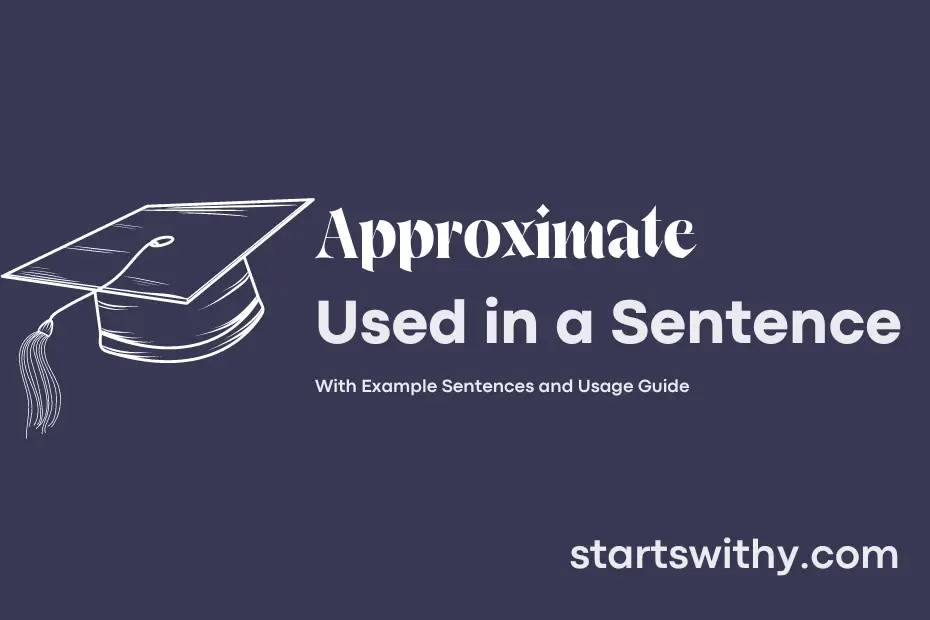Do you ever struggle with finding the right word to convey an estimate or close value? That’s where the term “approximate” comes in handy. When you use “approximate” in a sentence, you’re indicating that the information provided is an educated guess or a rough calculation, rather than an exact figure.
In everyday conversation, “approximate” helps us convey general ideas without claiming precise accuracy. Whether discussing dimensions, quantities, or time frames, this term allows for flexibility and a degree of estimation, making communication clearer and more practical.
7 Examples Of Approximate Used In a Sentence For Kids
- My approximate age is five years.
- Can you approximate how many candies are in the jar?
- Let’s play a game to approximate how many toys are in the box.
- The approximate time for lunch is 12 o’clock.
- I will approximate how long it takes to draw a picture.
- Try to approximate how many balloons are floating in the air.
- We can approximate the number of students in our class.
14 Sentences with Approximate Examples
- Approximate calculations are often used in physics experiments to simplify complex problems.
- Students can use an approximate value to estimate the final amount in a mathematical equation.
- It is important to provide an approximate date for the completion of the project to avoid any delays.
- Approximate measurements can be made using a ruler with centimeter markings.
- When conducting a survey, it is common practice to gather data from an approximate number of participants.
- Chemistry students can use an approximate mass to calculate the number of moles in a sample.
- In statistics, an approximate value can be used to represent a large set of data.
- Students can provide an approximate answer to a problem when they are short on time during an exam.
- When writing an essay, it is acceptable to give an approximate word count to stay within the limit.
- Approximate measurements can be useful when determining the volume of irregularly shaped objects.
- Calculating the distance between two cities can be done using an approximate value based on the average speed of travel.
- A rough sketch of a graph can help students get an approximate idea of the trend in the data.
- When analyzing a data set, it is common to use an approximate median if there are outliers present.
- Providing an approximate budget for a college event can help in planning expenses ahead of time.
How To Use Approximate in Sentences?
When Approximate is used in a sentence, it means to come close to a certain value or to estimate without exact precision.
Here is a simple guide on how to use Approximate in a sentence for beginners:
- Start your sentence with a subject. For example, “The scientist” or “She” or “They”.
- Insert the word Approximate in the middle of your sentence to convey an estimation or close value.
- Provide the context or what you are estimating. For instance, “Approximate the distance” or “The Approximate cost”.
- Follow Approximate with the value you are estimating. For example, “The scientist Approximate the age of the fossil to be around 10,000 years old.”
- Ensure that your sentence gives a clear idea that the value is an estimation rather than an exact figure.
Remember, Approximate is used when you are giving an educated guess or a rough calculation. It is not meant to provide an exact value. So, when in doubt about the accuracy of a number or measurement, using Approximate can signal to others that it is not precise.
Conclusion
In conclusion, using sentences with approximate can be a helpful way to convey information when exact figures are not available or necessary. These sentences provide a close estimate or rough idea of the quantity or value being discussed, allowing for a general understanding without requiring precise details. By using phrases like “approximately,” “around,” or “about,” writers can convey a sense of the magnitude while acknowledging the potential margin of error.
Whether specifying a timeframe, quantity, distance, or any other variable, sentences with approximate serve to offer a sense of scale while also allowing for flexibility in interpretation. They are a practical tool for communication, providing a level of detail that is suitable for many contexts without the need for exact data or measurements.



